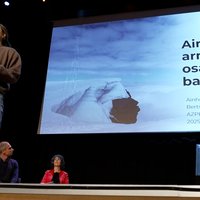The salty force
The technology required to convert the energy stored by the sea or the force of the waves into electricity is becoming more and more advanced. However, marine energy still faces a long road to develop as much as wind and other renewable energies.
Despite this, there are many systems and projects underway to harness the energy of the waves, and in the Basque Country there are also several projects to investigate and develop what could be the energy of the future.
In search of new and clean energies, one of the options is to look at the sea, which stores a lot of energy in its interior.
In the Basque Country, for example, you can take advantage of the force of the waves. In fact, the Basque coast is long and, in addition, the Bay of Biscay is often boasted. Throughout the year, the local waves have an average height of about 3 meters. The coast of the Basque Country is therefore an ideal place to exploit the energy of the waves.
The key is to invent the right techniques to be able to exploit this inexhaustible treasure. Considerable progress has been made in this area; however, marine energy technology is still far from being an alternative to other forms of energy.
Javier Marqués is director of renewable energies at the Basque Energy Agency. He believes that the energy coming from the waves will be of great importance in the future and hopes that Basque companies will be pioneers in this field.
JAVIER MARQUÉS; EEE-EVE: In the finals of the década próxima, between 2015 and 2020, a significant number of installations for the supply of wave energy will be added to the development of a significant development compared with the rest of renewable energies.
By the end of the next decade, between 2015 and 2020, there will be a significant number of facilities to harness the energy of the waves, from which it will actually begin to develop compared to the rest of the renewable energies.
To harness the energy of the waves of the sea, different technologies are being worked on. There are many systems with different development, but four are the most used.
The oscillating water column is currently one of the most developed of existing technologies for harnessing marine energy. When the wave arrives, water enters the chamber and compresses the internal air to then exit through the upper orifice with high pressure. The compressed air drives the turbine and the turbine drives the alternator to generate electrical power. As the wave recovers, it sucks air from the same hole and reacts to the turbine to continuously generate energy in constant motion. The turbines will have movable blades to take advantage of the thrust of the air flowing both upwards and downwards. This type of infrastructure must be located on the shore, and this is exactly the system that is being installed in Mutriku. The works are already well advanced: only the installation of turbines is missing. It will be the first multi-turbine plant in the world, with sixteen turbines that will generate electric power consumed by about 600 people among them.
On the other hand, by means of the wave overflow system, the water of the waves exceeding a certain height is collected in a reservoir, and by means of a water emptying process, electric power is generated. The Danish Wave Dragon device is one of the main examples of this system.
JAVIER MARQUÉS; EEE-EVE: It's a technology that's in an inhospitable state, but it's a technology that's thought to be applied to the sea. We think that the future of the energy of the waves, the futures of development are going to go into the sea, which is where the potential is. Save punctual applications as you can be the case of Mutriku, where the great potential is in the sea, it is to say, in facilities that are several miles from the coast. This technology is already demonstrated and it is believed that the future can also have an important development.
The technology is incipient, but it is a technology that is designed for marine applications. We believe that the future of wave energy and future developments will take place on the high seas, where the potential lies. With the exception of specific applications such as this one in Mutriku, a great strength lies in the sea, that is, in facilities several miles from the coast. This technology has already been tested and is expected to undergo significant development in the future.
The wave force can also be converted into electricity by means of buoys: with a floating structure, energy from all directions is collected by surface or internal movements of the water. An example of this technology is very close to the Basque coast: In Santoña, a fleet of ten buoys is being installed.
The shock absorber system, known as Pelamis, is a floating structure that flows up and down over waves and is capable of converting oscillating motion induced in the manner of a sea serpent into electrical energy.
JAVIER MARQUÉS; EEE-EVE: It is possible to say that the system is such that it is most likely to meet at the global level. The first experience of the Tuvieron in Scotland, in the Horcade Islands, where there is a center of experimentation that is the EMEC. And then there's Iberdrola Renovables through its subsidiary Scottish Power, which has already co-located several types of systems Pelamis also Scotland.
Perhaps you could say that it is the most advanced system in the world. Their first experience was in Scotland at the EMEC Experimentation Centre on the Orkney Islands. Iberdrola Renewable, through its subsidiary Scottish Power, also plans to install several Pelamis-type systems in Scotland in the near future.
The Basque Country is also working on the development of technology to harness the energy of the waves. Between Iberdrola and Tecnalia, Oceantec has been created: it is a new system to boost wave energy. Last year the prototype was developed on a 1:4 scale and tested in the waters of Pasaia. When the real-size machine is made, it is expected to supply the consumption of 1000 homes. The challenge for this Basque technology will now be to achieve high performance and competitive cost.
Oceantec will be one of the technologies to be investigated at the BIMEP Bizkaia Marine Energy Platform, among others. The BIMEP centre will be built in Arzana and its objective will be to test the technology and infrastructures that will generate marine energy.
It will have two zones: one at sea for the location of prototypes of energy converters and another on land for the monitoring and control of the equipment to be tested from there.
JAVIER MARQUÉS; EEE-EVE: In this moment we live diverse technologies. Pass something to stop you going through your day with the wind energy: that now the windmills have all the same aspect, they are of three blades, but in their day they have three blades, of two blades, of one blade, of the vertical axis, of the horizontal axis... Now there is a group of technologies that are competing, and effective, the technology that is going to be the most influential and the most influential in the world of technology. It is true that there are different technologies that exist, at this moment we find ourselves in a phase in which there are multitudes of prototypes, with aspects of the most diverse. And well, there's one thing that's cattle. Our hope is that it is one, and in the measure of what is possible, that it is Vasca, that it is here.
There is a lot of technology going on at the moment. Something similar to what happened at the time with wind power is happening: all the mills now have the same appearance, they have three arms, but at the time there were three blades, two blades, one blade, vertical axis, horizontal axis... There is now a competing set of technologies, and this is the moment to see which technology will advance the most and which will win. It is true that there will be different technologies; we are in a phase with a large number of prototypes of many appearances at the moment. And, well, one will be victorious. Our bet is that it is one and, as far as possible, that it is Basque, that it is from here.
The Basque Energy Agency estimates that 10% of the energy needs in the Basque Country could be met by waves. But for the time being, this is a matter of the future, because today marine technologies generate little and expensive electricity. It will take a lot of time and money, but as research progresses, so will the yield. The salty force is expected to gain importance, as the sea can be an inexhaustible source of energy.
Buletina
Bidali zure helbide elektronikoa eta jaso asteroko buletina zure sarrera-ontzian










